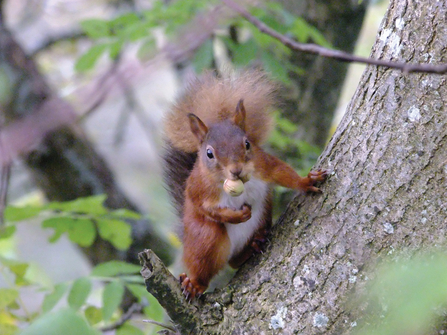
Red squirrel at Smardale Nature Reserve © Andrew Walter

Red squirrel at Smardale Nature Reserve © Andrew Walter
One of the biggest citizen science efforts in mammal conservation in the UK has shown red squirrel populations across northern England are stable. This is thanks to over 30 community red squirrel groups which work tirelessly to protect the red squirrels on their doorstep.
One hundred and sixty people, mostly volunteers, completed the annual monitoring programme this spring. This is the seventh consecutive year of the monitoring programme, led by Red Squirrels Northern England, a project managed by Northumberland Wildlife Trust, which creates an exciting picture of our native red squirrels’ geographical range in northern England.
Trevor Cooper from Grasmere Red Squirrel Group said: “Repeating these surveys, same time, same place, shows that year after year reds are still present in our woodlands around Grasmere, proving that the hard work we put in is paying off”.
Results show that red squirrels are still widely distributed across six counties in northern England, with red squirrels found in 42 per cent of survey sites and grey squirrels in 48 per cent.
The surveys take place in ‘red squirrel counties’ across northern England, where wild red squirrels can still be found: in Cumbria, Northumberland, Tyne & Wear, North Yorkshire, Lancashire, Merseyside and parts of County Durham.
Surveys are completed within areas where red squirrel conservation is carried out by project teams, such as Red Squirrels Northern England, and by local community red squirrel groups under the banner of Northern Red Squirrels.
Simon O’Hare, Project Manager for Red Squirrels Northern England, has hailed the result as another positive for red squirrels. He says: “This year there was a very slight drop in the number of sites with reds, down from 45 per cent in 2017. This is no cause for alarm, as slight variations over time are common in mammal populations. We have seen this pattern before, and know that we are documenting fluctuations in red and grey squirrel populations, affected by environmental factors such as bad weather and bumper natural food supplies in the autumn.
“However, it is vital that we do not see a drop in conservation effort. Over the last seven years, results from the annual surveys show that what we are collectively doing to conserve reds in the north of England is working, but it needs to be long-term. We need to secure continued support if we are to sustain this achievement”
Grey squirrels out-compete reds for food and also carry a fatal virus, squirrelpox virus, which they are immune to. Over 99% of reds known to catch the virus die within two weeks.
In addition to the surveys, over 300 people sent in records of red squirrel sightings between March and May, showing that reds were present in 350 2x2km squares and highlighting places where they were not seen during surveys.
In Northumberland, Nick Leeming chair of Northern Red Squirrels said: “Reds are bouncing back in areas of Northumberland, for example around Cramlington, Morpeth and Ashington, where people are putting in the effort to look after them. They have also been seen in the city of Newcastle again in 2018”.
Year after year reds are still present in our woodlands around Grasmere, proving that the hard work we put in is paying offTrevor CooperGrasmere Red Squirrel Group